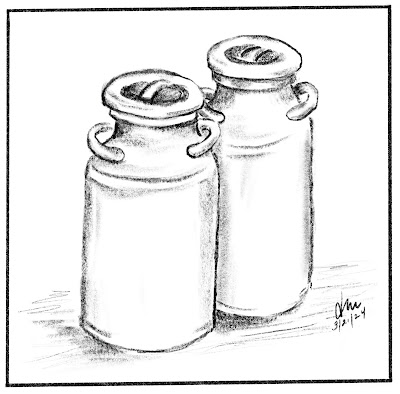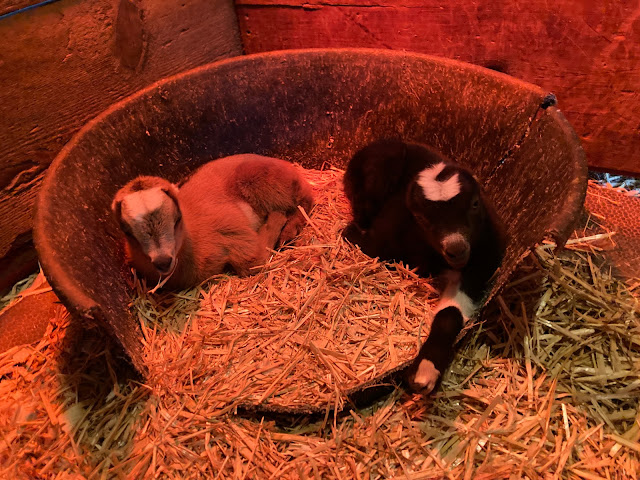'What in the world have you been doing?" asked Toby. "You're way behind."
"I know, I know! You're right. The truth is I've been writing, but just not on the blog."
"Are you writing a book?"
"Well, no. The other day I remembered that my granddaughter Sonja had asked me a long time ago to write some recipes for meals I made at her house when I was visiting. I was surprised when I looked at old files on the laptop that I still had what I'd printed and sent to her. When I paged through them, I could see they often veered off into story-telling. So, I began to write some background for them. It looks like I'm doing some family story-telling. So that's what's been taking up my time."
"Are you going to tell me a story now? You know how bored I am."
"Well, yes, I could do that. I don't think it'll cure your boredom though. Do you want me to tell you the Milk Cans story? It's that background writing I've been working on."
"Sounds like a good place to start. Go ahead."
"Are you sure? It's a little longer than usual."
"That's okay, no problem, I'll just go to sleep if it's too long. Go ahead." He sat up like a student in a front-row classroom seat.
I wondered how long it would take for a cat nap. "Okay, here goes..."
***
In the summer of 1952, Mom and Dad, my four younger siblings—a brother, three sisters, and I ages one through 12— moved into a rural Missouri farmhouse after a long series of uprootings, both in and out of state, due to Dad's various work relocations. The farmhouse, barn, and outbuildings had been abandoned by that time except for the mice and rats still thriving on the remaining contents of what had once been a granary building.The farm’s owner still cultivated most of the fields though he and his wife had moved to town. His tractor and equipment sat around the property wherever convenient for him to leave it. Retired machinery from the earlier horse and mule power era was everywhere inside and outside the farm’s buildings. A very early edition of a truck sat rusting on its tire-less hubs in the barn lot. Multiple dust and cobweb-covered harnesses lined the barn tack room. Those were a source of fascination and longing for me to put them to use with the two retired workhorses, a bay mare and brown gelding, that lived in the connecting barbwire fenced barn lot and pasture eating grass in summer, and in winter hay brought in from the fields--the bales stored in the vast hay loft. Their water came from a perch, catfish, and frog pond in the barn lot. A second, unconnected small pond lay behind one of the outbuildings in a fallow field that was a source for wild ducks and, no doubt, plenty of other wildlife. We never saw any deer because by that time their population had been seriously decimated though that hadn’t yet entered my awareness.
The owner's brother didn’t farm. He had pursued a heating oil trucking business selling to local townspeople and farms, including us. Our two 50-gallon oil drums were linked to our single heater in the living room and to the kitchen stove. Both were our only source of heat in winter because the house chimneys were unusable, filled with soot and deterioration.
We dwelled in that corrugated, tin-roofed farmhouse among its outbuildings, barn, abandoned orchard, and 160 acres during my seventh-grade through high school days. Among the region's hills, bluffs, creeks, and woods was the human touch of sloping crop fields, pastures, ponds, fences, and farm structures. Narrow, dirt roads reinforced here and there by creek gravel were barely wide enough to pass oncoming vehicles which were mostly a few neighbors and the Rural Free Delivery (RFD) postman. (No women.) Our mailbox sat at the end of our quarter-mile lane on the edge of that road. In the summertime, a healthy patch of poison ivy grew around the mailbox. Even with great care to avoid touching the growth, I still got that itchy rash from time to time carrying out my chore to get the mail. Eventually, I became immune to poison ivy.
The farmhouse we rented was located between two small towns, each roughly three miles away in opposite East-West directions. To the West was the county seat. The road in that direction forded a creek three times. During those early '50s years, the county's one-room, rural schoolhouses were closing and consolidating with the town schools which were at the same time handling the increasing student counts by sending elementary children to scattered classrooms in the defunct, local college buildings and an unused church. In contrast, a new high school was under construction. Later, when the eighth-grade and high school kids could move into the new structure, the first through seventh-grade students all attended classes in the old high school building. To the East of our farm acreage, the road crossed only one creek over a small metal and wood-planked floor bridge. A couple miles further East it met the highway to a string of small towns and eventually, St. Louis. On late summer nights from my bedroom's open windows, I could hear the bridge’s boards clatter when my dad's pickup crossed it on his way home.
The area was served by a multi-party telephone of the early variety wooden box on a wall with a front-facing mic and a receiver on a cord that hung on the side. A crank on the other side was to alert the telephone operator in town to put a call through to the number you told her. (Yes, woman.) Or, put your call through yourself to a neighbor on the party line by cranking a code ring for them--the operator was one long crank. Our ring was one short and two longs. The codes rang on everybody's line so neighbors were free to pick up their receiver and listen to your conversation which diminished the volume. We didn't call very much because to connect via the operator, there was a 20¢ charge and that was not allowed by mom and dad.
Weather affected the electric line bringing power to us. There were no other utilities. The landlord's promised toilet installation never became a reality. Behind the house, next to the old granary was a two-hole outhouse. There was a hand pump at the kitchen sink that brought water up from a cistern outside which was replenished from the house roof's rain runoff into gutters and downspouts. Undrinkable, but used to wash anything or ourselves, and for anything boiled on the stove. The sink drain went on a direct line to the vegetable garden. Detergents weren't in wide use until later years. Hot water on rubbed Ivory Soap bars was used for dish-washing.
Sometimes, the cistern ran low, so to conserve it for kitchen use my mom and I went to a second cistern located near the outbuildings to get water for clothes washing or our wash tub baths. There, we moved two of the several heavy planks covering the cistern out of our way, tied a rope to a bucket, lowering to fill it with water; then, hoisted it up, bucket after bucket, to fill the wash tub balanced on my brother’s Radio Flyer red wagon to be pulled back to the farmhouse back porch.
We had no car. Mom didn't drive. Dad’s pickup was in service of his drive to and from work 50 miles away over the 1950s mostly two-way US Highway 40 into the city of his birth and childhood, St. Louis. He worked many union construction jobs operating and repairing heavy equipment and motors.
Dad brought home our drinking water in two, five-gallon, stainless steel milk cans from which Mom carefully, as needed, transferred water to scalded Mason jars she then refrigerated. The milk cans probably cost much more than the $25 monthly rent for the plumbing-less old farmhouse. That was low-rent even by 1950s standards but a brag-worthy item of discussion during Dad's many after-work stops for a quick one at the multiple small-town establishments along his homeward route. The two big milk cans frequently went with him for replenishment with fresh water at a gas station, or wherever there was a handy spigot. He supplied the family’s drinking water in this way for eight years—long after I’d finished high school and left.
My mother, for her part, literally fed us from the large expanse of garden alongside the house. Like most people in early 20th-century trolly suburban towns in St Louis County where she grew up, she knew gardening and chickens from first-hand experience and family heritage. Her mother was from a farm family close to the rural town of Sullivan, Missouri. Mom put that knowledge into use where we now lived.
A decade later, when Hippies were going “back to Nature” living off the land, I said, “No thanks, been there, done that!”
***
Toby had slid onto his side and now looked at me upside-down.
He asked, "Did you have any cats to enjoy all those well-fed mice and rats? Oh, and who in the world were the Hippies?"
"Yes, definitely, we had cats. We'll get to them another time. You might say the Hippies were a generation of young people in the 1960s that kinda emerged like the earlier Beatnik generation. By the Hippies' time, the Beatniks were getting older and ironing their blue jeans. Hippies wanted to get away from material stuff and opposed the Vietnam War. They said, "Make love, not war!" and pretty much did that which was helped along with their investigations of weed and mushrooms in the communes where a lot of them lived. After about another decade rolled by, the hippies were older and started ironing their blue jeans, wearing bras, and patching holes in their shirts."
"What became of all the weed and mushrooms?"
"Oh, that all went underground for a long time. The last few years though they're making a comeback in a newer science kind of way."
Toby said, "Far out!"
 |
| Make love, not war! |





